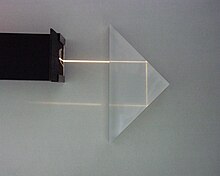
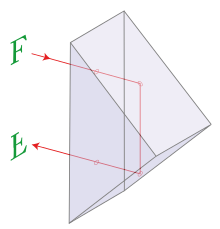
In optics, a Porro prism, named for its inventor Ignazio Porro, is a type of reflection prism used in optical instruments to alter the orientation of an image.


In optics, a Porro prism, named for its inventor Ignazio Porro, is a type of reflection prism used in optical instruments to alter the orientation of an image.
It consists of a block of material shaped like a right geometric prism with right-angled triangular end faces. In operation, light enters the large rectangular face of the prism, undergoes total internal reflection twice from the sloped faces, and exits again through the large rectangular face. When the light enters and therefore exits the glass at normal incidence, the prism is not dispersive.
An image travelling through a Porro prism is rotated by 180° and exits in the opposite direction offset from its entry point.
While a single Porro prism can be constructed to work as well as a roof prism, it is seldom used as such. Therefore, to reduce the cost of production for a Porro prism, the edge of the roof is usually left out. Sometimes only one small window as an entrance surface and one window as exit surface are polished. The distinction between a roof prism and a Porro prism is that for the roof prism the roof edge lies in the same plane as entrance and exit beam, while for a Porro prism the (left out) roof edge is orthogonal to the plane formed by the beams. Furthermore, the roof prism has no displacement and a deviation typically between 45° and 90°, while in a single Porro prism the beam is typically deviated by 180° and displaced by a distance of at least one beam diameter.
Porro prisms can reflect light rays that are not parallel to the optical axis in such a manner that they are internally reflected off the hypotenuse of the prism. Such an abaxial ray then emerges from the prism having been reflected a third time, thus introducing non image-forming stray light and reducing contrast. Abaxial reflections can be eliminated by putting a groove or notch across the width of the hypotenuse face center of the prism, which blocks these detrimental reflections.
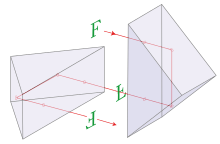
Porro prisms are most often used in pairs, forming a double Porro prism. A second prism rotated 90° with respect to the first, is placed such that light will traverse both prisms. The net effect of the prism system is a beam parallel to but displaced from its original direction, with the image rotated 180°. A double Porro system provides four internal reflections. Since the light is reflected an even number of times, the image's handedness is not changed.
Double Porro prism systems are used in small optical telescopes to re-orient an inverted image (an arrangement is known as an image erection system), and especially in many binoculars where they both erect the image and provide a longer, folded distance between the objective lenses and the eyepieces. When there is an air gap between the two prism there are four glass/air transition surfaces.
Sometimes, the two components of the double Porro system are cemented together, and the prisms may be truncated to save weight and size and reduce glass/air transition surfaces to two and hence light transmission loss.
There is also a Porro prism of the second type [1] variant, which consists of three prisms of different shapes that can be and commonly are cemented together and also deflects the beam path four times by 90°. A double-reflecting half-cube prism is placed between two smaller, only once-reflecting half-cube prisms. The principal sections of the outer prisms are arranged at right angles to the central prism. [2] Its advantage is that there is no vertical offset of the beam path. Porro prism of the second type optical systems are not very common and generally applied in larger and military binoculars. [3] [4] [5]
Another variant of the Porro prism of the second type with the same function is the Porro–Abbe prism; a two prisms variant that reduces the lateral beam axis offset by 23% compared to a traditional double Porro prism system in binoculars. [6] [7]
The Porro–Abbe two prisms variant has been further developed into the Perger prism, which combines the properties of Porro and roof top prism, requiring only a small offset of the beam path and also enabling a measuring beam or an illuminated display to be reflected through the changed angle of the reflection surfaces and the cemented surface. As of 2013 Perger prisms are commercially used on a small scale in Perger–Porro prism system binoculars with integrated laser range finders. [8] [9]

Traditionally binoculars used a double Porro prism design, which resulted in a distinctive offset, zig-zag shape. Roof prism designs allow a simpler exterior, and are now common but they are more expensive to produce. Complicating production requirements make high-quality roof prism design binoculars relatively costly to produce compared to in optical quality equivalent Porro prism binoculars. [10] [11] [12] [13] Good-quality Porro prism design binoculars often feature about 1.5 millimetres (0.06 in) deep grooves or notches ground across the width of the hypotenuse face center of the prisms, to eliminate image quality reducing abaxial non image-forming reflections. As human eyes are ergonomically limited by their interpupillary distance the offset and separation of big (60+ mm wide) diameter objective lenses and the eyepieces becomes a practical advantage in a stereoscopic optical product.
In the early 2020s the commercial market share of Porro prism type binoculars had become the second numerous compared to other prism type optical designs. [14]
Most single lens reflex cameras use a roof pentaprism, and therefore have a distinctive top "peak". By contrast, a Porro prism allows a much tidier design, as used in the following models:

Optics is the branch of physics that studies the behaviour and properties of light, including its interactions with matter and the construction of instruments that use or detect it. Optics usually describes the behaviour of visible, ultraviolet, and infrared light. Because light is an electromagnetic wave, other forms of electromagnetic radiation such as X-rays, microwaves, and radio waves exhibit similar properties.
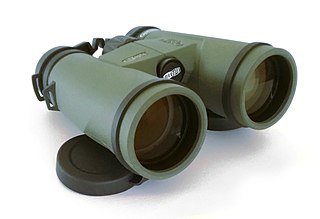
Binoculars or field glasses are two refracting telescopes mounted side-by-side and aligned to point in the same direction, allowing the viewer to use both eyes when viewing distant objects. Most binoculars are sized to be held using both hands, although sizes vary widely from opera glasses to large pedestal-mounted military models.

A monocular is a compact refracting telescope used to magnify images of distant objects, typically using an optical prism to ensure an erect image, instead of using relay lenses like most telescopic sights. The volume and weight of a monocular are typically less than half of a pair of binoculars with similar optical properties, making it more portable and also less expensive. This is because binoculars are essentially a pair of monoculars packed together — one for each eye. As a result, monoculars only produce two-dimensional images, while binoculars can use two parallaxed images to produce binocular vision, which allows stereopsis and depth perception.
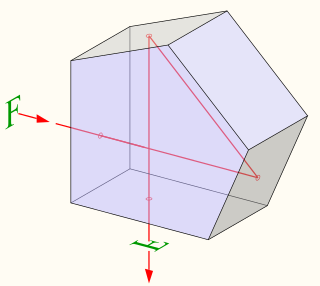
A pentaprism is a five-sided reflecting prism used to deviate a beam of light by a constant 90°, even if the entry beam is not at 90° to the prism. The beam reflects inside the prism twice, allowing the transmission of an image through a right angle without inverting it as an ordinary right-angle prism or mirror would.
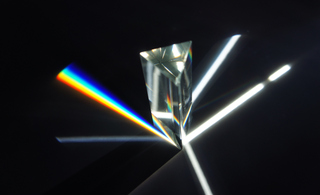
An optical prism is a transparent optical element with flat, polished surfaces that are designed to refract light. At least one surface must be angled — elements with two parallel surfaces are not prisms. The most familiar type of optical prism is the triangular prism, which has a triangular base and rectangular sides. Not all optical prisms are geometric prisms, and not all geometric prisms would count as an optical prism. Prisms can be made from any material that is transparent to the wavelengths for which they are designed. Typical materials include glass, acrylic and fluorite.
Optics is the branch of physics which involves the behavior and properties of light, including its interactions with matter and the construction of instruments that use or detect it. Optics usually describes the behavior of visible, ultraviolet, and infrared light. Because light is an electromagnetic wave, other forms of electromagnetic radiation such as X-rays, microwaves, and radio waves exhibit similar properties.

A monochromator is an optical device that transmits a mechanically selectable narrow band of wavelengths of light or other radiation chosen from a wider range of wavelengths available at the input. The name is from the Greek roots mono-, "single", and chroma, "colour", and the Latin suffix -ator, denoting an agent.

A Dove prism is a type of reflective prism which is used to invert an image. Dove prisms are shaped from a truncated right-angle prism. The Dove prism is named for its inventor, Heinrich Wilhelm Dove. Although the shape of this prism is similar to the shape described by a Dovetail joint, the etymology of the two is unrelated.

A dichroic prism is a prism that splits light into two beams of differing wavelength (colour). A trichroic prism assembly combines two dichroic prisms to split an image into 3 colours, typically as red, green and blue of the RGB colour model. They are usually constructed of one or more glass prisms with dichroic optical coatings that selectively reflect or transmit light depending on the light's wavelength. That is, certain surfaces within the prism act as dichroic filters. These are used as beam splitters in many optical instruments.

An optical coating is one or more thin layers of material deposited on an optical component such as a lens, prism or mirror, which alters the way in which the optic reflects and transmits light. These coatings have become a key technology in the field of optics. One type of optical coating is an anti-reflective coating, which reduces unwanted reflections from surfaces, and is commonly used on spectacle and camera lenses. Another type is the high-reflector coating, which can be used to produce mirrors that reflect greater than 99.99% of the light that falls on them. More complex optical coatings exhibit high reflection over some range of wavelengths, and anti-reflection over another range, allowing the production of dichroic thin-film filters.

A Porro–Abbe prism, named for Ignazio Porro and Ernst Abbe, is a type of reflection prism used in some optical instruments to alter the orientation of an image. It is a variant of the more common double Porro prism configuration.

An Abbe–Koenig prism is a type of reflecting prism, used to invert an image. They are commonly used in binoculars and some telescopes for this purpose. The prism is named after Ernst Abbe and Albert Koenig.

An Amici roof prism, named for its inventor, the Italian astronomer Giovanni Battista Amici, is a type of reflecting prism used to deviate a beam of light by 90° while simultaneously inverting the image. It is commonly used in the eyepieces of telescopes as an image erecting system. It is sometimes called an Amici prism or right angle roof prism. The non-dispersive Amici roof prism should not be confused with the dispersive Amici prism.

A roof prism, also called a Dachkanten prism or Dach prism, is a reflective prism containing a section where two faces meet at a 90° angle, resembling the roof of a building and thus the name. Reflection from the two 90° faces returns an image that is flipped laterally across the axis where the faces meet.

A Schmidt–Pechan prism is a type of optical prism used to rotate an image by 180°. These prisms are commonly used in binoculars as an image erecting system. The Schmidt–Pechan prism makes use of a roof prism section. Binoculars designs using Schmidt–Pechan prisms can be constructed more compactly than ones using Porro or Uppendahl roof and Abbe–Koenig roof prisms.

A coincidence rangefinder or coincidence telemeter is a type of rangefinder that uses mechanical and optical principles to allow an operator to determine the distance to a visible object. There are subtypes split-image telemeter, inverted image, or double-image telemeter with different principles how two images in a single ocular are compared. Coincidence rangefinders were important elements of fire control systems for long-range naval guns and land-based coastal artillery circa 1890–1960. They were also used in rangefinder cameras.

A Perger prism or Perger–Porro prism system is a prism, that is used to invert an image. The special feature of this prism is that, like a traditional double Porro prism system, it manages this with only four beam deflections and has neither a roof edge with the accompanying phase correction problems, a mirrored surface or an air gap. However, in contrast to the traditional double Porro prism, it leads to a significantly reduced eyepiece/objective axis offset. The reduced beam offset allows for slimmer, more straight binocular housings usually found in roof prism binoculars. Complicating production requirements make high-quality roof prism binoculars relatively costly to produce compared to in optical quality equivalent Porro prism or "Perger–Porro prism system" binoculars.

A prism sight or prismatic sight, sometimes also called prism scope or prismatic scope, is a type of telescopic sight which uses a reflective prism for its image-erecting system, instead of the series of relay lenses found in traditional telescopic sights. The use of prisms makes it possible to construct a shorter and lighter sight, or with an offset between the eyepiece and objective axes.
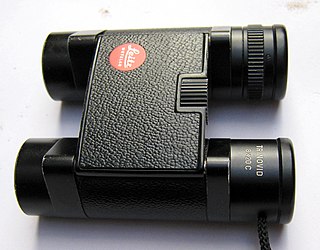
An Uppendahl prism is an erecting prism, i.e. a special reflection prism that is used to invert an image. The erecting system consists of three partial prisms made of optical glass with a high refractive index cemented together to form a symmetric assembly and is used in microscopy as well as in binoculars technology.
Trinovid is the protected model designation of a roof prism binoculars series from the company Leitz (optics) based in Wetzlar, a German centre for optics as well as an important location for the precision engineering industry.